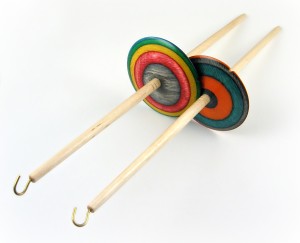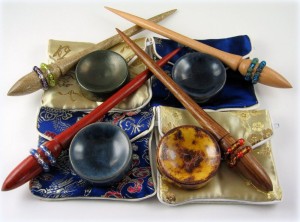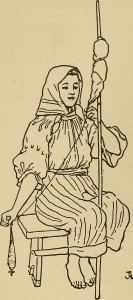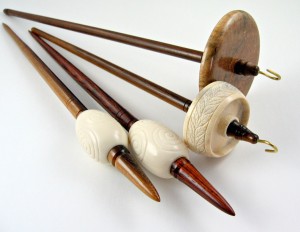Introduction to Spindles Around The World
By Molly Ferriter – 16 Comments| One of the hot crochet-related items on many crocheters Christmas list this year was a spindle for hand-spinning yarn. Spindles come in a plethora of types, styles, and models. Many are a mini-art pieces, with beautiful woodwork, designs, and colors. Hand spinning yarn, for me, has become a sister addiction to my out-of-hand crochet addiction! This is the first post in a series that plans to explore hand spindles from around the world. I’m so excited to be writing about a new passion of mine- hand spinning yarn! |
Spindles have been around since the Neolithic age, possibly earlier, with parts of spindles being found in Archaeological sites around the world. Spinning is a universal human activity performed throughout all of human history and cultures. While today, yarn shops and large yarn companies have eliminated the need for crocheters to spin their own yarn, a lot of us have caught the spinning bug and spin our own yarn for our crochet projects. Many people collect spindles, not only for spinning, but just for their artistic value. The yarn created by hand spinning is as diverse as the spindles. In a variety of textures and colors, “art yarn” is enjoyable to crochet with, making one-of-a-kind creations.

Bottom Whorl Drop Spindle by Dave Stanbrough
How do Spindles Work?
Handspun yarn is made of natural fibers that are drafted, or pulled into long strips, then twisted. When the fiber is twisted, or “spunâ€, the fibers are brought together into long, miniature ropes. When spun, the fibers hold together and are hard to pull apart, or break. Before being spun, the fiber can be easily separated and do not hold together.
A spindle is generally a straight stick or spike, that contains a weight, called a whorl. The whorl is usually a disc made of wood or stone, which serves as a weight that helps the spindle spin faster. Many spindles do not have a whorl, but are thickened towards the bottom for weight.

Russian Support Spindles by Dan Stanbrough
Photo by Iconwaym/ Flikr

Hungarian Hand Spinning/ Public Domain Photo
Many of the older European spindles are larger is size, and the fiber is held on a long stick-like tool, called a distaff. As far as I know, the distaff is most generally used in older Europe traditional spindles. I have even seen types of spindles as small as a couple inches. The variety of spindles is astounding. They are working pieces of art, holding cultural traditions, history, and the human experiences in their carvings.
I would love to hear about your experiences with spindles. Are you a hand spinner? Do you collect spindles? Are you as obsessed with spindles, too? Leave your comments below!



I look forward to this series of posts. I want to learn more about hand spinning, and perhaps one day give it a try.
Great! The next post in the series is the drop spindle. That’s a great spindle to try first.
Count me as another who s ready to see the rest of the series. Even though I have a lot of spindles and a wheel already, I like to look at all the different pretty things that are available.
Great, Candace! I just got into spinning this past year and am already addicted! I can’t wait to explore new types of spindles.
I have a couple of spindles and cannot find any one to demonstrate how to make them work! I am one of these who needs to SEE it happening before I manage to master it. I hope you can help me out as getting to a fiber-fest has been impossible so far….due to work….
Hi, Micaela! I learned how to use my drop spindle with videos on YouTube. There is a large community of spinners that make how-to videos on youtube. Just go to your search engine and type, “how to use drop spindle youtube” and it will search youtube for you. That’s how I first learned. My daughter is learning to spin from videos as well.
That is a great idea, I would have never thought to go their I was thinking of a fair or such in the area where you live I went to a small one last year & saw a woman spinning, & even bought one of her projects she made it was beautiful. She used Alpaca wool it was so soft.
I actually spin my own yarn from time to time. I spin it out of various things like dryer lint (cause you can) and when I was brushing out yarn to make fuzzy amigurumi, I’d use the brushed out fuzz to make more yarn. Drop spindles are a lot of fun and take some time to get used to but one can learn in about a week to use one.
I was told they’re the gate way to learning how to use a lap spindle too. Which I eventually want cause I have friends with sheep. 😀
I am very jealous of your friends with sheep! I don’t have any acquaintances locally that have sheep. Lucky you!
Thank you for writing this! I just started spinning in 2015 and it seems like the major spinning magazines that I’ve read, the fiber festivals I’ve attended and most of the fiber web sites haven’t yet recognized the interest that crocheters are taking in spinning. Some spinner/designers have but the industry as a whole seems to be partial to knitting and weaving. It’s understandable. Crochet is not an old a craft as weaving and knitting; however, I think that the fiber industry would do well to recognize this growing trend. Great job, Molly.
Exactly, Lisa!!! I really feel that the crocheters are left out of the loop regarding hand-spinning. I find almost NOTHING when I look for spinning information as it relates to crocheting. There is definitely a huge gap in information and material available to crocheters versus what is available for knitters.
I was taught to use a drop spindle by a vendor at our local Renaissance Faire several years ago. I absolutely love spinning. I’ve made my own spindles and have a few that are so beautifully made that I consider them works of art. It can be a meditative practice too. There are many good videos dedicated to the types and how to use drop spindles. Using the words *drop spindle spinning* in a search should yield some interesting information.
I completely agree with you that many spindles are a piece of art. How wonderful that you have made your own! It is definitely meditative. I always feel a bit more serene after spinning.
I, too, want to see and hear more. I saw a lady use her dog’s hair to make her yarn and the pieces she made from it were beautiful. Another lady I saw had a spindle around her waist, and as she walked around, she spun. That was so cool.
Linda, I saw someone spin dog hair, too! This may sound strange, but when my 9 year old daughter was learning how to spin on her drop spindle, she actually spun microfiber polyfill. She was able to spin with it. She’s now progressed to wool, but still likes to spin it, “just for fun”.
I learned because of wanting to spin Collie fur. It’s been great. I love the history f the spinning, largely from the Andean of region and Central America. I am, however, deeply disappointed in how much conflicting information is online. Had to get the courage to go into a much more experimental mode as so many people promote themselves as experts who have the only way to spin.
My husband has made me several spindles, so I’m developing quite a collection. I like them on the heavy side.
Thank you for this wonderful series of articles.